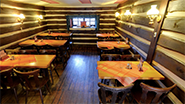Tips for trips > Vrchlabi
Vrchlabi occupies an area of 28 sq km at an elevation of 477 m above sea level. It has 13, 550 inhabitants. Thanks to its position in the middle of the mountain range Krkonose it is called the „entrance gateway“.
First references about the settlement called Vrchlabi can be found in old records from the 14th century. The Krkonose and adjacent areas have always been rich in gems and ores. Therefore, the majority of its inhabitants were miners and founders working on the ore mining and processing.
The Emperor Ferdinand I granted Vrchlabi the mining right at the beginning of the 16th century when the estates belonged to Krystof Gendorf. In 1533 the settlement was promoted to a mining town with its own emblem and rights (the original promotion letter-patent is placed in the district archives in Trutnov; a copy in Vrchlabi town council). The town thrived thanks to mining. Krystof Gendorf had a new stone church and vicarage built. He organised Protestant church, set up a school and a poorhouse. Moreover, he summoned German speaking miners and mining experts to the town and between 1546 – 1548 he promoted the construction of a renaissance castle. Albrech from Valdstejn bought the castle with the estates in 1624. During the short period of his administration Vrchlabi experienced unprecedented bloom. After his death his property was confiscated. In 1635 the Emperor Ferdinand II. gave it to Imperial Earl Rudolf Morzin in recognition of his war services in the war against the Turks and Swedes. In 1882 the whole estates devolved upon the Czemin – Morzins.
The arrival of Czechoslovak army and sports organisation Sokol to Vrchlabi put paid to Germans' endeavour to separate it from the newly established independent Czechoslovak Republic after the First World War. Nevertheless in September 1938 the frontier regions including Vrchlabi had to be given away to Hitler Germany as a result of Munich Dictate. The liberation on 8th May 1945 brought Vrchlabi's administration back to Czech hands. The most significant places of interest are the renaissance castle and the St. Augustin's monastery with church. Vrchlabi's dominant is the town hall. Another interesting sights are St. Vavrinec's decanal church, Marian plague column, St. Ann's group of sculptures from the 17th century, folk architecture represented by the 17th century houses in the square of Peace, the bridge over the river Elbe and many others. The Krkonose museum's collections, archives and a library are also worth visiting. The town's appearance has changed recently. Many new buildings were built and old facades repaired mainly because the property was handed back to private ownership. At the end of 1992 the work on the most demanding and expensive project – building new sewerage network – has started. It should be completed by the end of 2003. Business enterprises have been developing at very fast pace, commercial network has expanded and the number of new private restaurants has increased. The town is becoming a tourist centre by means of providing various services such as transport and goods supplying which are missing in the centre part of Krkonose. The Flying School residing in Vrchlabi organises observation flights above picturesque Krkonose region and its vicinity.
Opening hours of the restaurant Country Saloon in Dvur Kralove
- Monday - Thursday: 10:00 - 23:00
- Friday: 10:00 - 24:00
- Saturday: 11:00 - 24:00
- Sunday: 11:00 - 22:00
Our restaurant is non-smoking
Book by calling +420 499 321 596
Dogs are welcome in our restaurant
Do not be worry about your pets! They are also welcome here!!




